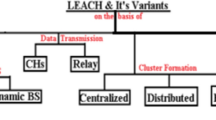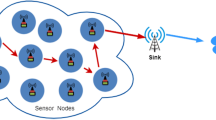Abstract
Wireless sensor networks (WSNs) has recently drawn lots of attention due to its application in multiple domains. The sensors have limited power sources and in many applications they cannot be recharged or replaced due to hostile nature of the environment. Finding near optimal solutions for the energy problem is still an issue in WSNs. A new era is opened with algorithms inspired by nature to solve optimization problems. In this paper, we propose genetic algorithm based approaches for clustering and routing in WSNs. The objective of this mechanism is to prolong lifetime of a sensor and increase the quality of service. We perform extensive simulations of the proposed algorithms and compare the simulation results with that of the existing algorithms. The results demonstrate that the proposed algorithms outperform the existing algorithms in terms of various performance metrics including energy consumption and number of packets received by the base station.
























Similar content being viewed by others
Notes
The Duty-Cycle is a technique used by the node sensor to save energy by switching periodically between the sleep mode “sleep” and the active mode “awake”. The main idea is to reduce the unnecessary activity time of the node, the sensor woke up only in the time of the transmission or reception of data.
References
Fogel, J., et al. (1966). Artificial Intelligence through Simulated Evolution. New York: Wiley.
Schwefel, H. P. (1981). Numerical optimization of Computer models. New York: Wiley.
Darwin, C. (1859). On the origin of species. London: John Murray.
Holland, J. (1975). Adaptation in natural and artificial systems. Ann Arbor: University of Michigan Press.
Ferentinos, K. P., & Tsiligiridis, T. A. (2007). Adaptive design optimization of wireless sensor networks using genetic algorithms. Elsevier Computer Networks, 51(4), 1031–1051.
Jia, J., et al. (2009). Energy efficient coverage control in wireless sensor networks based on multi-objective genetic algorithm. Computers and Mathematics with Applications, 57(11–12), 1756–1766.
Bhondekar, A. P. et al. (March 2009). Genetic algorithm based node placement methodology for wireless sensor networks. In The international multi-conference of engineers and computer scientists, (pp. 18–20). Hong Kong, China.
Song, Y., et al. (2015). A genetic algorithm for energy-efficient based multipath routing in wireless sensor networks (pp. 2055–2066). Berlin: Springer.
Miao, H. et al. (September 2015). Improvement and application of leach protocol based on genetic algorithm for WSN. In 20th international workshop on computer aided modelling and design of communication links and networks (CAMAD), (pp. 242–245). Toronto, ON, Canada.
Wazed, S. et al. (2007). Genetic algorithm based approach for extending the lifetime of two-tiered sensor networks. In the 2nd international symposium on wireless pervasive computing (ISWPC07).
Hussain, S. et al. (April 2007). Genetic algorithm for energy efficient clusters in wireless sensor networks. In The fourth international conference on information technology (ITNG07), (pp. 147–154). Las Vegas, USA.
Ait El Hadj, F. S. (2013). Approche de dtection de communauts chevauchantes dans des rseaux bipartis. Phd Thesis in computer science, Univ. Mouloud Mammeri, Tizi ouzou, Algeria.
Cerf, R. (1994). Une thorie asymptotique des algorithmes gntiques. Phd Thesis in computer science, Univ. Montpellier II, Montpellier, France.
Eshelman, L. J. et al. (1989). Biases in the crossover improvement and application of leach protocol based on genetic algorithm for WSN. In The third international conference on Genetic algorithms, (pp. 10–19). San Francisco, CA, USA.
Chandrakasan, A., Balakrishnan, H., & Heinzelman, W. (2000). Energy-efficient communication protocol for wireless sensor networks. In The international conference system sciences, Hawaii.
Heinzelman, W. R. et al. (October 2002). An application-specific protocol architecture for wireless microsensor networks. IEEE Transaction on Wireless Communications, 1(4), 660–670.
Bayrakli, S. et al. (2012). Genetic algorithm based energy efficient clusters (gabeec) in wireless sensor networks. In The 3rd international conference on ambient systems, networks and technologies, (pp. 247–254). Turkey, Istanbul.
Mohammed, A., et al. (2014). A new energy-efficient adaptive clustering protocol based on genetic algorithm for improving the lifetime and the stable period of wireless sensor networks. International Journal of Energy, Information and Communications, 5(3), 47–72.
Author information
Authors and Affiliations
Corresponding author
Additional information
Publisher's Note
Springer Nature remains neutral with regard to jurisdictional claims in published maps and institutional affiliations.
Rights and permissions
About this article
Cite this article
Hamidouche, R., Aliouat, Z. & Gueroui, A.M. Genetic Algorithm for Improving the Lifetime and QoS of Wireless Sensor Networks. Wireless Pers Commun 101, 2313–2348 (2018). https://doi.org/10.1007/s11277-018-5817-z
Published:
Issue Date:
DOI: https://doi.org/10.1007/s11277-018-5817-z




